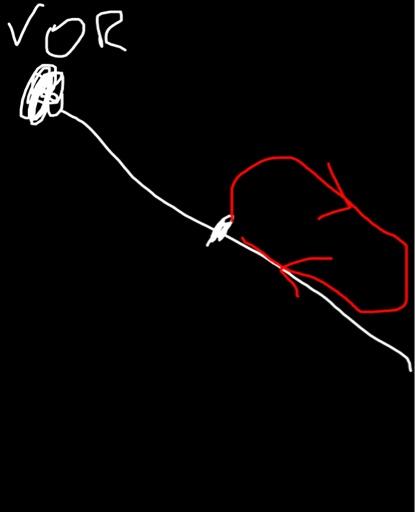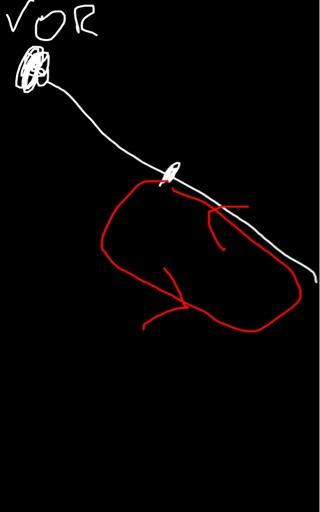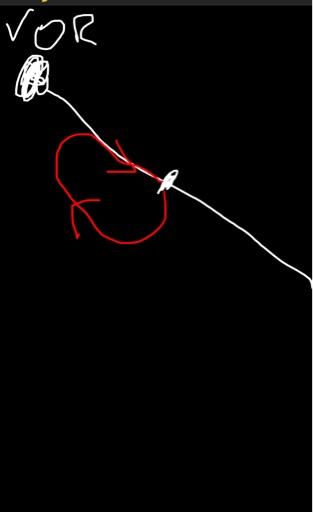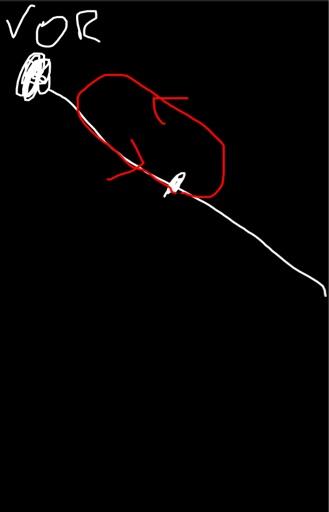MauleSkinner
Touchdown! Greaser!
Exactly why they wouldn’t issue that.huh?
Exactly why they wouldn’t issue that.huh?
You are not understanding what I am saying.Exactly why they wouldn’t issue that.
But the radial in the holding clearance is from the fix. The fix may be defined by the 110 radial from the VOR, but if you’re holding northwest, it’s the 290 radial from the fix.You are not understanding what I am saying.
The 110 at 15 is the fix. You can hold northwest of the fix and still be on the 110 radial.
That’s not a full holding clearance.In the op 1st post, where would the fix be if the clearance was hold northwest of ABC VOR 10 DME?
No… the radial in the clearance is from the VOR. That radial combined with the DME creates the holding fix.But the radial in the holding clearance is from the fix. The fix may be defined by the 110 radial from the VOR, but if you’re holding northwest, it’s the 290 radial from the fix.
Look at aterpsters link above. It has a diagram that may clear it up.I completely understand Mauleskinner. Kritchlow is a bit confusing.
I was thinking the fix was the VOR as was stated on diagram above.
From the instrument procedures handbook, and I’m sure the verbiage is the same everywhere else…<my comments>No… the radial in the clearance is from the VOR. That radial combined with the DME creates the holding fix.
you’re not making the distinction between the radial for the name of the fix and the radial for the course.The holding instructions include the direction from the fix<northwest>, name of the fix<XYZ 110 radial, 15 DME>, course<290 radial>, leg length, if appropriate, direction of turns (if left turns are required), and the EFC time.
The fix is still in the same place.I guess what I meant to say is, Where is the fix if NW was substituted for SE in original post?
The fix is in the same place. ABC vor radial 110 at 15 DME. That will not change.I guess what I meant to say is, Where is the fix if NW was substituted for SE in original post?
On the northwest side of the fix.Got it.
Where is the hold if clearance was NW in the OP?
Let’s back up to this…ok, I am confusing two things here…, but not the VOR and the fix, I’m confusing “of” and “on”, probably because neither was in @brcase ’s post, so I added the wrong one.I believe you are confusing two different things here.
Remember that when you're at the fix, the hold is "starting" and you turn. Remember also that inbound legs are always towards the fix.
In the OP's example, to be NW of the fix you'd have to fly left hand turns, and your inbound leg would be heading 110 (flying along radial 110).
To be NE of the fix you'd have to fly right hand hand turns, and your inbound leg would be flying heading 290 (on the 110 radial).
If it’s on the NW side of the fix it will. That’s the only way to know which side of the fix to hold on.
Four possible quadrants. Need two pieces on info to determine which quadrant.
1) Direction from fix (NW etc…)
2) Direction of turn
Not quite, the quadrant only tells you which side of the fix the inbound leg is on. Since they did not specify left turns the inbound leg is 110 with right turns (hold NW) or 290 with right turns(hold SE), you are correct you always start the turn at the fix, you never fly directly way from the fix for the hold. With the exception Ps parallel and teardrop hold entries, but we don’t draw the entry until after we have drawn the holding pattern.Remember that when you're at the fix, the hold is "starting" and you turn. Remember also that inbound legs are always towards the fix.
In the OP's example, to be NW of the fix your inbound leg would be heading 110 (flying along radial 110). You would make a left hand turn when you first hit the fix / entered the hold, fly outbound parallel to the 110 radial heading 290, then turn left again to rejoin the 110 radial as you fly inbound back the fix.
To be NE of the fix you'd have to fly right hand hand turns, and your inbound leg would be flying heading 290 (on the 110 radial).
You didn't have a pen and paper? I couldn't do the simplest hold until I realized I could draw the clearance which made its location and the entry easy.I hate to sound like an old timer, but back in the old days we had to visualize all holds in our head, published or unpublished. Now with the magenta line and the airplane icon, you don't have to imagine anything, except with these unpublished holds. It is really straight forward. You just need to draw the magenta line in your head.
I was going to do that and saw yours. Picture is perfect, but in your explanation,All you need to know is they are going to give you a fix and the "inbound" leg. with the possiblity of non-standard turns. or designated leg length.
for your example
Fix = 110 Radial off the ABC VOR (the is the fix)
Inbound Leg = 110 Radial on the SE side of the fix.
So draw a point (the fix) then draw the line (110 Radial) then put an arrow on the inbound side pointing to the fix (SE side of the 110 Radial), then when cross the fix make a turn (right is standard since you didn't specify) Fly outbound then turn back to you inbound leg
View attachment 113055
Brian
CFIIG/ASEL
You can fly left or right patterns on either side of the fix.

…..
You'd have to turn left (if you turned right, you'd then be NE of the fix).




No. @eman1200's drawings are correct.Sure.
For me, I read the OP's situation as
1) There is a fix on radial 110
2) The fix is 15 miles from the VOR
3) Hold SE of that
To keep SE of that fix, you'd come from the SE and be on a 290 heading at the point you hit the fix and entered the hold.
You'd have to turn left (if you turned right, you'd then be NE of the fix).

Thank you for all of the great responses.... and of course a question always leads to another question.....
Holding @ the 15 DME gives you 4 options of how the racetrack is flown. If you were to hold @ the ABC VOR on the 110 radial there is only 2 options L or R... correct ?
Yes, except it's not your option, it's ATC'sThank you for all of the great responses.... and of course a question always leads to another question.....
Holding @ the 15 DME gives you 4 options of how the racetrack is flown. If you were to hold @ the ABC VOR on the 110 radial there is only 2 options L or R... correct ?
I wrote an article about that for ALPA in 1999:
There should be no options, it should be clear, if not, ask. In your example here there is just one option.
Seems like the radial is extremely revelant for finding the fix. Could be wrong though. I'm still learning this stuff.

